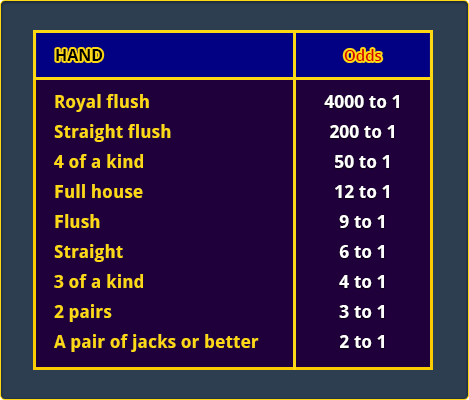Double Down Stud Poker
Double Down Stud Poker almost doesn’t qualify as a video poker game at all. In fact, it’s played in 2 versions—an electronic version and a table version. But since almost all other video poker games are based on 5 card draw, Double Down Stud Poker is a real anomaly in the family of games.
This page provides a detailed tutorial on how to play Double Down Stud, both as a table-based game and as a video poker game. It also includes strategy advice and pay table and payback percentage details.
How to Play Double Down Stud Poker
Almost all video poker games work the same way—you input money. You choose how many coins to bet. You’re dealt a 5 card hand, and you decide which cards you want to keep and which cards you want to discard. Then you get replacement cards and a payoff based on the poker hand ranking of the cards you finish with.
The discarding and replacement of cards is what’s considered a hallmark of “draw poker”, which is more or less the opposite of “stud poker”, where you don’t get to discard anything and replace anything.
And since this is a stud poker game, that’s exactly what happens. You get cards, but you don’t get the option of discarding any of them. Instead, you get the option of doubling the size of your bet at a certain point.
Here’s how the game works:
You place your bet, then you’re dealt a single card. Then the community cards are dealt. (That’s an odd name for these cards in the video poker version, since you’re just playing by yourself, but in the table game version, those cards are shared by everyone at the table.)
There are 4 community cards. 3 of them are face up, and one of them is face down.
Based on your estimation of how well you’re doing with the card in your hand and the 3 cards you can see, you can decide whether or not to double your bet.
Once you’ve decided, the face down card gets turned over. You then get paid off based on the strength of your hand, according to the game’s pay table.
The pay tables are based on those of other video poker games, and the pay table is what determines the game’s payback percentage. We cover that in detail in the next section.
Double Down Stud Poker Pay Tables
Double Down Stud Poker doesn’t have a unique pay table. Instead, it borrows pay tables from other video poker games, like Jacks or Better or Bonus Deuces. Here’s an example of the pay table for the version based on Jacks or Better (which is more common):

Of course, if you double the size of your bet, the size of the payoff doubles, too. So you could win 8000 coins for a royal flush if you’ve doubled the size of your bet.
Observant readers will notice that the payoffs on these hands are significantly higher than the payoffs in a regular Jacks or Better game. That’s because you don’t get a chance to discard and try to improve your hand, so they can afford to pay off more for each hand.
The payback percentage for this game is about 98% if you play with correct strategy. Luckily, the strategy for this game is much simpler than for any other variation of video poker we know of. After all, the only decision you have to make is whether or not to double the size of your wager.
Here’s a word of explanation about payback percentages, which we explain in detail on our main video poker page. That’s just a piece of jargon used in gambling writing to illustrate the long term expectation for the game. It’s expressed as a percentage. Over the long run, this is what the casino math says the casino will pay out in winnings on a gambling game.
For example, if you say that a game has a payback percentage of 98%, the casino expects to pay an average of $98 back in winnings for every $100 that a player bets. But this is a long-term expected number. In the short run, players often go on winning streaks or losing streaks. Since the casino is in it for the long haul, the math guarantees their profit.
Double Down Stud Poker Strategy
In almost every other video poker game, you have a lot of possible decisions for how to play a hand. After all, you can keep or discard each card, so that’s 10 decisions right there. But you also get to decide whether to keep or discard each of those hands in combination with the other cards, which makes for a total of 32 different ways to play a video poker hand.
But in Double Down Stud Poker, you only have a single decision to make:
Here are the only situations where you will double your bet:
- If you have a pair of 6s or better.
- If you have 4 cards to any of the following hands: flush, straight flush, or royal flush.
- If you have an outside straight draw. (That’s 4 cards to a straight with no gaps—you can fill the straight with a higher card or a lower card. An inside straight can only be filled by a card of one rank—an outside straight can be filled by one of 2 cards, which doubles your chances of hitting the hand.)
Double Down Stud Poker, along with Pick’em Poker, is one of the easiest video poker variations you can play—almost entirely because of the lack of a lot of decisions to make.
Conclusion
Double Down Stud Poker can almost be considered a simplified version of video poker. The limited number of decisions you’re able to make create a game where the strategy can be explained in 3 short sentences. The payback percentage for the game isn’t exceptional, though, but at 98%, it’s still considerably better than almost any slot machine game you’ll come across.
Double Down Stud Poker can also be played as a table game, which is also unusual for a video poker game. When played as a table game, it uses community cards, making it similar in some ways to a hold’em game. But we consider it a stud game because of the contrast between it and other video poker games where you get to “draw” additional cards.
 75%
75% 80%
80%
